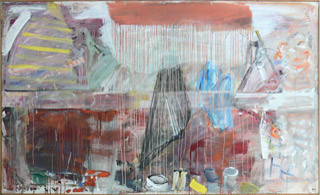Gheorghe Ilea
12 - 31 Mar 2010
GHEORGHE ILEA
10 Paintings
Opening March 12, 18 – 22h
March 12 – 31, 2010
Tuesday – Saturday, 12 – 18 h
Heidestrasse 50, 10557 Berlin
Galeria Plan B is pleased to announce the first solo exhibition in Germany of the Romanian artist Gheorghe Ilea (born 1958, lives and works in Zalau, Romania).
Among the long-term projects of Plan B, one strand of research and exhibition engages and seeks to revaluate a group of remarkable painters active in Romania between 1970–2000. We believe the works these artists produced can contribute to a more nuanced understanding of the period when they were made, and that they have not lost any of their poignancy in the intervening years. These works visualize a double removal: they were made at a distance from the official artistic establishment of the '70s and '80s, and have not succumbed, like many of their contemporaries, to a mimetic rehearsal of international models after '89. In the majority of cases, the paintings never left the studio, and were undervalued, both culturally and economically, after 1989. We are proposing them as possible landmarks in a yet-unwritten history of the Romanian art scene, but also as models of artistic and social behavior.
The exhibition brings together paintings made by Gheorghe Ilea between 1987–2007. Seen together, and removed from the vicious circles of national culture, with its identitary obsessions, empty hierarchies and artificial market, the works return to their immediate context: Ilea's investigation into the seductiveness of images. He persistently explores the boundary between consistency and a certain hypnotic density in his images. Although a shapeshifter, with effects and solutions ranging from the heavily gestural to the hyperrealist, Ilea has been assimilated to the mystical, neo-Orthodox dogma in Romanian painting through the '90s. Yet it has to be noted that the most interesting painters of that group are the ones least burdened by religious symbols, those in whose work painting wins over pious search and monastic predisposition. With Ilea, the neo-orthodox doctrine does not prevail over painting, and the latter manifests a sustained interest in the world around, with its smaller and greater things, an interest for which there can be no single rhetorical encoding. There is an intellectual exuberance fueling the works, with paintings as medium of research, rather than safe aesthetic bet or mystical springboard. The result is remarkable, in both its power of observation and seduction.
10 Paintings
Opening March 12, 18 – 22h
March 12 – 31, 2010
Tuesday – Saturday, 12 – 18 h
Heidestrasse 50, 10557 Berlin
Galeria Plan B is pleased to announce the first solo exhibition in Germany of the Romanian artist Gheorghe Ilea (born 1958, lives and works in Zalau, Romania).
Among the long-term projects of Plan B, one strand of research and exhibition engages and seeks to revaluate a group of remarkable painters active in Romania between 1970–2000. We believe the works these artists produced can contribute to a more nuanced understanding of the period when they were made, and that they have not lost any of their poignancy in the intervening years. These works visualize a double removal: they were made at a distance from the official artistic establishment of the '70s and '80s, and have not succumbed, like many of their contemporaries, to a mimetic rehearsal of international models after '89. In the majority of cases, the paintings never left the studio, and were undervalued, both culturally and economically, after 1989. We are proposing them as possible landmarks in a yet-unwritten history of the Romanian art scene, but also as models of artistic and social behavior.
The exhibition brings together paintings made by Gheorghe Ilea between 1987–2007. Seen together, and removed from the vicious circles of national culture, with its identitary obsessions, empty hierarchies and artificial market, the works return to their immediate context: Ilea's investigation into the seductiveness of images. He persistently explores the boundary between consistency and a certain hypnotic density in his images. Although a shapeshifter, with effects and solutions ranging from the heavily gestural to the hyperrealist, Ilea has been assimilated to the mystical, neo-Orthodox dogma in Romanian painting through the '90s. Yet it has to be noted that the most interesting painters of that group are the ones least burdened by religious symbols, those in whose work painting wins over pious search and monastic predisposition. With Ilea, the neo-orthodox doctrine does not prevail over painting, and the latter manifests a sustained interest in the world around, with its smaller and greater things, an interest for which there can be no single rhetorical encoding. There is an intellectual exuberance fueling the works, with paintings as medium of research, rather than safe aesthetic bet or mystical springboard. The result is remarkable, in both its power of observation and seduction.

